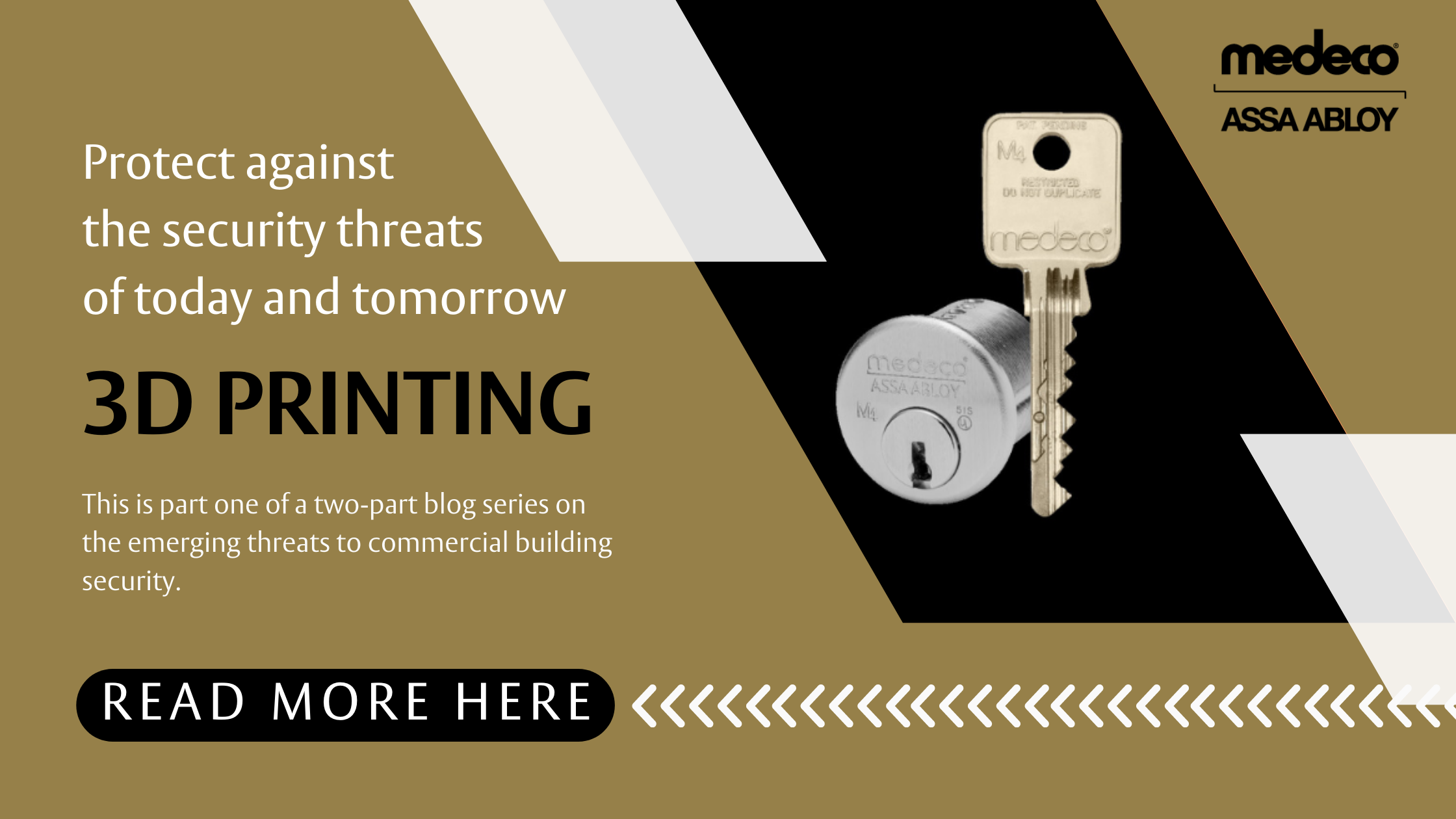Protecting Against Security Threats of Today and Tomorrow: 3D Printing
3D-printing phantom keys sounds like a threat of the distant future. But the reality of technological advances and the de-personalization of key cutting brings the threat of traceless keys closer and closer every day.

3D-printing phantom keys sounds like a threat of the distant future. But the reality of technological advances and the de-personalization of key cutting brings the threat of traceless keys closer and closer every day.
This blog is the first installment of a two-part series on the emerging threats to commercial building security, including advancements in 3D printing technologies and the rise of unmanned key machines. To learn about how unauthorized key duplication is made simpler with unattended key cutting kiosks, click here.
Emerging Threats to Security
When it comes to commercial, federal, and industrial buildings, the traditional door security threats are the usual suspects—drilling, bumping, prying, striking, picking, and unauthorized key duplication. These threats, while still around today, are thought to be easily mitigated with key blank patent protections and durable, high-security locksets with drill, pick, and bump resistance.
But what’s on the horizon?
Recent years have seen an uptick in 3D printing accessibility and innovations. On the surface, these technologies seem like harmless advancements, developed to make the process of manufacturing and cutting keys easier and quicker. But the actual impact could be a little more sinister.
3D printing is more accessible than ever
3D printing is an exciting technology, making manufacturing and prototyping quicker, easier, and cheaper. But 3D printing is no longer futuristic high-tech; it’s readily available. As the technology evolves, it becomes more powerful, more affordable, and more accessible—even to the “bad guys.”
A key advantage of 3D printing is the ability to create and replicate incredibly complex features that are otherwise only attainable with high-cost, high-volume subtractive manufacturing like CNC machining. This capability makes replicating even the most difficult-to-cut keys simple, adding a whole new dynamic to the concept of unauthorized key duplication.
In other words, complex keys that would traditionally be difficult to cut or require access to a patent to cut are now easy to scan and copy without the owners’ knowledge, increasing the risk of illegitimately copied keys.
And 3D printing isn’t the only way to copy a key without the owners’ knowledge. The increasing implementation of automated, unmanned kiosks removes the personal interaction and vetting process that has previously verified that a person is authorized to duplicate a key.
The rise of phantom keys
These technologies are likely to create an unprecedented amount of phantom keys, making key inventory and secure access control increasingly difficult. Since the duplication of these keys isn’t traceable, neither are the keys that become circulated in use, making it more and more difficult to manage the people and parties who have access to physical spaces. And as the technologies continue to grow, so will the problem of unauthorized key duplication, and the investment required to protect your properties.
The bottom line? The growing accessibility of 3D printing is not only putting your customers, employees, and their assets at risk, but taking money out of your pocket.
Moveable elements make replicating keys with 3D printing much more complex
While 3D printers are capable of replicating intricate, fixed models, they have their limits.
As with any component, the more complex the mechanics, the more difficult to reproduce. Conventional keys have fixed features, so their attributes are fairly simple for printers to scan and replicate. To make duplication more difficult, some manufacturers have implemented a moveable element into new key designs to combat the threat of unauthorized duplication.
The moveable element works by moving within the key blade as the blade enters the lock and encounters the lock’s mechanisms. For instance, Medeco produces an M4 key with a patented moveable element. In the M4, the key’s design includes a shuttle pin security feature. The shuttle pin moves back and forth inside the key blade as it activates the lift pins inside the lock, protecting against 3D printing and adding to the security of the cylinder. And since the element isn’t static, a 3D printer is challenged to reproduce the shuttle pin across all of its latitudes in the blades. This provides an added layer of protection against unauthorized key duplication.
Learn more about Medeco 4 high-security keys and cylinders here.
New security threats are on the horizon. Prepare your facilities with proactive solutions.
While 3D printing duplicate keys is not a widespread threat today, their presence is increasingly growing. As these tools become more accessible to those with bad intentions, they will become a more commonplace issue.
Make sure you’re protecting against the threats of today and future-proofing against the threats of tomorrow with strategic key systems for your commercial, federal, and industrial buildings. And locksmiths – it’s up to you to educate and inform your customers about the emerging threats and the right key systems for their threat landscape. These systems will not only protect and add to your customers’ bottom line, but yours as well.
If you're interested in learning about how keys with moveable elements better protect your commercial spaces, fill out the form below to get in touch.